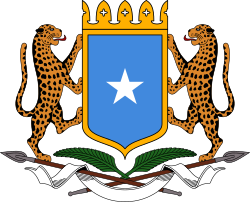 | |
| Use | National flag and ensign |
|---|---|
| Proportion | 2:3 |
| Adopted | 12 October 1954 |
| Design | A single white five-pointed star centered on a blue field |
| Designed by | Mohammed Awale Liban |
The national flag of Somalia was adopted on October 12, 1954, and was designed by Mohammed Awale Liban. The flag was initially used within the Trust Territory of Somaliland [1] before being adopted by the short-lived State of Somaliland and the Somali Republic. It is an ethnic flag for the Somali people; the flag's five-pointed star represents the five regions in which Somalis reside. [2]


























